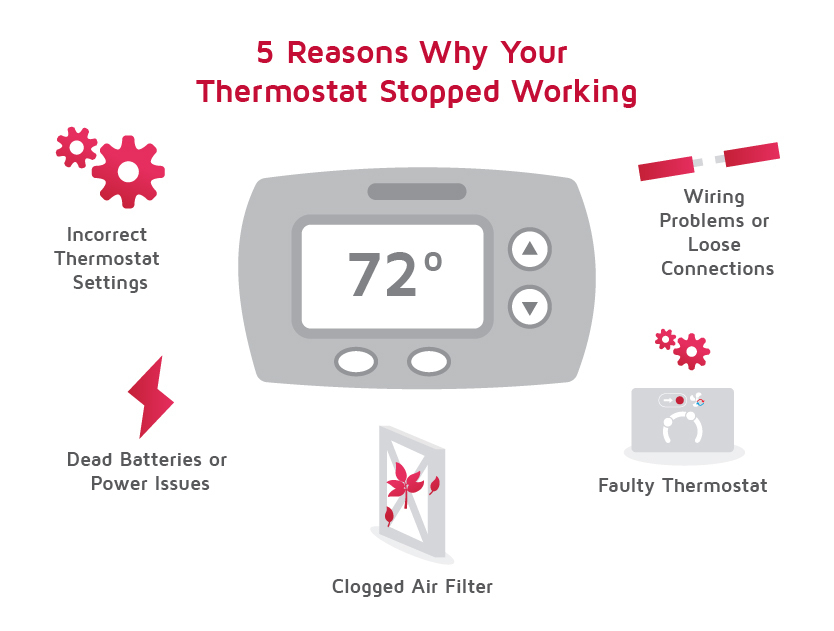Here’s What You Need to Know
When the chill of winter starts creeping in, the last thing any homeowner wants is a thermostat that says “heat on” but no heat is actually coming through the vents. A thermostat not turning on heat is a common issue that can stem from something as simple as incorrect settings—or something more complex within your HVAC system. Understanding the possible causes, trying a few basic troubleshooting steps, and knowing when it’s time to call a professional can save you time, money, and a lot of cold nights.
Why Your Thermostat Isn’t Kicking the Heat On?
When your thermostat fails to activate the furnace or heat pump, the issue could be with the thermostat itself, the power supply, or the heating system it controls. Here are some of the most common culprits:

- Incorrect Thermostat Settings
It may sound obvious, but sometimes the thermostat heat setting isn’t adjusted properly. Double-check that the thermostat is set to “Heat” mode, and that the temperature is set higher than the current indoor temperature. If your thermostat is programmable, review the schedule to make sure it aligns with your comfort needs.
- Dead Batteries or Power Issues
If your thermostat is battery-powered, weak or dead batteries may prevent it from sending the signal to turn on the furnace. Replace the batteries with fresh ones to rule this out. For wired thermostats, check your home’s electrical panel for tripped breakers or blown fuses.
- Wiring Problems or Loose Connections
Thermostats rely on wiring to communicate with the furnace or heat pump. Over time, connections can become loose, corroded, or damaged. If your thermostat isn’t communicating with the furnace, professional inspection is the safest path forward, since electrical troubleshooting should be handled by a licensed technician.
- Clogged Air Filter
A dirty air filter can cause your heating system to overheat and shut down as a safety precaution, which may look like the thermostat isn’t turning on heat. Regular filter changes not only protect your system but also ensure better indoor air quality and efficiency.
- Faulty Thermostat
If you’ve confirmed that settings, batteries, and power are all correct, and your heating system still won’t respond, the thermostat itself may be failing. Signs of a bad thermostat include unresponsive controls, temperature readings that don’t match the actual room temperature, or no signal being sent to the HVAC system.

Troubleshooting Steps You Can Try
Before calling for service, a few basic troubleshooting steps may help resolve the problem:
- Reset your thermostat: Most models allow you to perform a factory reset. Check your user manual for instructions, as the process varies by model.
- Replace the batteries: For battery-operated units, swap in new batteries to eliminate this simple but common issue.
- Check thermostat settings and schedule: Verify that the heat setting and target temperature are correctly programmed. Adjust schedules if your thermostat runs on a timed program.
- Inspect the furnace or heat pump: Look for error codes or unusual sounds that may point to system issues rather than thermostat problems.
If you’ve worked through these steps and your heat still won’t turn on, the problem may be deeper within the system.
How the Thermostat Controls Your Heating System
Your thermostat is essentially the control hub for comfort in your home. It constantly measures the indoor temperature and signals the furnace or heat pump to turn on or off to maintain your chosen settings. If that communication breaks down—due to wiring issues, faulty sensors, or an internal failure—the thermostat may appear to be working, but no heating occurs.
When to Call a Professional?
While some issues can be solved with DIY fixes, others require the expertise of a trained HVAC professional. You should schedule service if:
- You’ve replaced batteries and reset settings, but the heat still won’t turn on.
- You notice error codes or flashing lights on the furnace or thermostat display.
- You hear unusual noises from your heating system, such as banging, humming, or constant clicking.
- You suspect damaged wiring or are uncomfortable handling electrical components.
A professional will not only diagnose and repair the issue but also ensure your system is safe, efficient, and ready for winter’s demands.
Maintaining Your Thermostat and Heating System
Preventive care is the best way to keep your thermostat and heating system running smoothly:
- Check and replace batteries regularly in battery-powered thermostats.
- Dust and clean your thermostat to prevent buildup from interfering with sensors.
- Schedule seasonal HVAC check-ups so that a professional can test the thermostat, inspect connections, and confirm your furnace or heat pump is ready for the season.
- Change air filters every one to three months, depending on household needs, to avoid unnecessary system shutdowns.
These small steps not only extend the life of your thermostat but also help your HVAC system run more reliably and efficiently.
Staying Warm With Confidence
When your thermostat says “heat on” but your furnace isn’t responding, it can be frustrating—but often the fix is straightforward. By checking thermostat settings, replacing batteries, and making sure your heating system is in good condition, you can often restore warmth to your home quickly. For persistent problems or signs of deeper system issues, professional help is the safest and most effective solution.
With regular care, your thermostat and heating system will keep working together to maintain the comfort your family relies on, even on the coldest days of the year.

